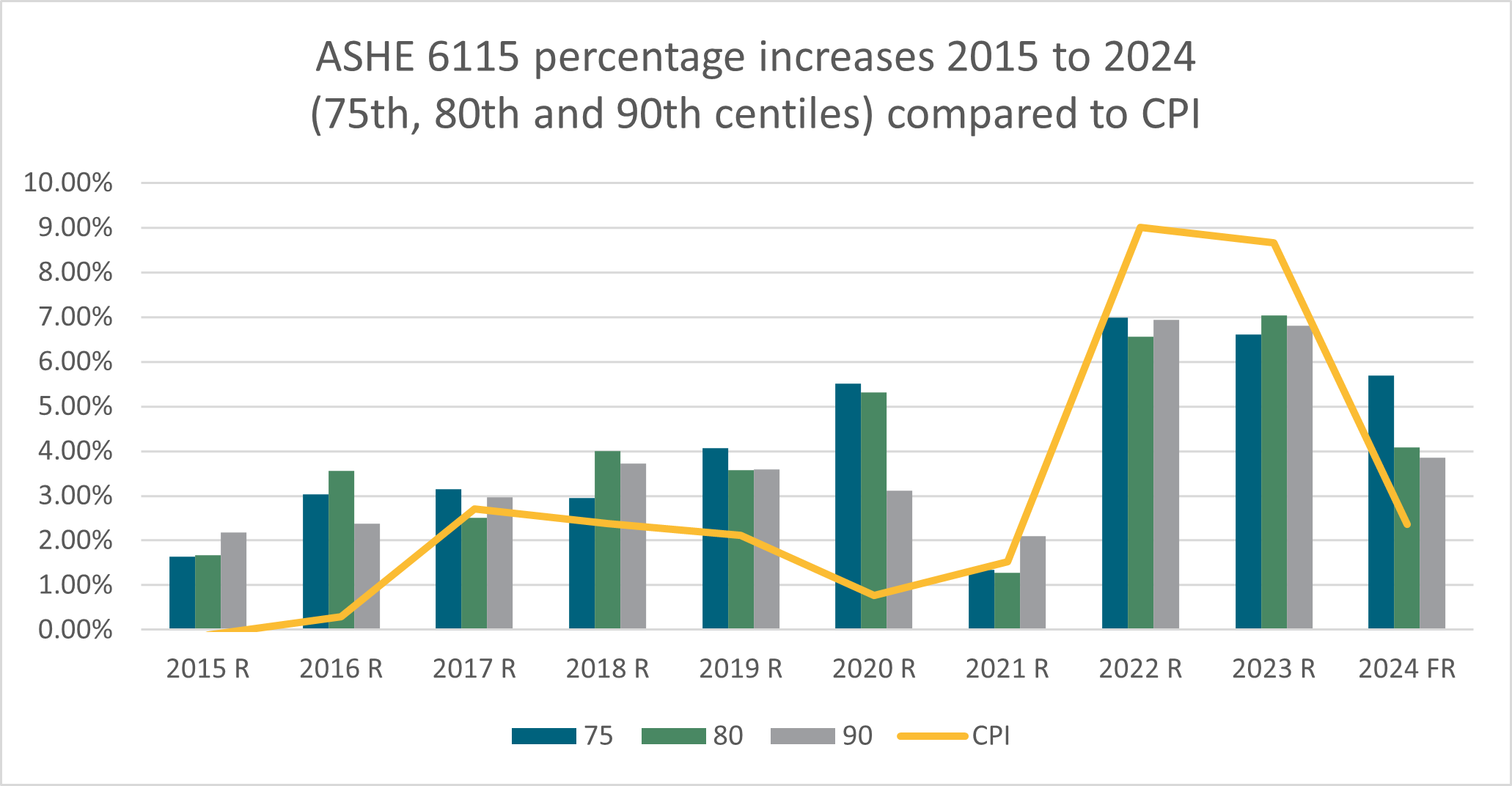ASHE figures published for Care Workers in 2024
-
Insight Article 2024年11月6日 2024年11月6日
-
英国和欧洲
-
People dynamics
-
保险和再保险
The provisional figures for the Annual Survey of Hours and Earnings (ASHE) 2024 have now been published together with the revised 2023 figures.
It is noteworthy that there have been some larger than usual adjustments between the 2023 provisional (2023P) and revised figures (2023R) for all employees as illustrated below:
| 2023R | 2023P | |
|---|---|---|
| Median weekly earnings for all full-time employees | 687.00 | 681.70 |
| Median weekly earnings for all full-time carers | 498.40 | 498.40 |
| Median hourly earnings for all full-time employees11.97 | 17.60 | 17.48 |
| Median ourly earnings for all full-time carers | 11.97 | 11.96 |
| Median hourly earnings for all employees | 16.00 | 15.88 |
| Median hourly earnings for all carers | 11.90 | 11.89 |
This is the result of changes to the processing of the survey data to improve the quality of the ASHE estimates resulting in more high earners in each profession being included in the final data and has led to larger than usual revisions for the 2023 data. As part of the 2022 to 2023 increase is due to a change in how the underlying data is processed, care must be taken when making comparisons between the 2022 (and earlier) and 2023 revised figures.
Consideration is being given to using this new method for the 2022 data (and earlier) which would enable comparisons to be made. In the meantime, we present the published figures noting the potential disconnect between them although, based on the above table, the impact appears limited with regard to carers earnings.
The full government release can be found here.
As in 2023, the latest figures show that full-time carers overall weekly earnings have increased more than full-time earnings in general, largely driven by the increase in the National Living Wage (NLW). Full-time carers earnings have increased substantially more than inflation (CPI/RPI) although this is effectively a ‘time lag’ following two years of high inflation.
| % Change 2023R to 2024P |
% Change 2022R to 2023R |
% Change 2022R to 2023P |
|
|---|---|---|---|
| Median weekly earnings for all full-time employees | 6.0% | 7.0% | 6.2% |
| Median weekly earnings for all full-time carers | 8.2% | 9.4% | 9.4% |
| National Living Wage (for those age 21 and over [1]) | 9.8% | 9.7% | 9.7% |
| Retail Prices Index (RPI) | 3.3% | 11.4% | 11.4% |
| Consumer Prices Index (CPI) | 2.4% | 8.7% | 8.7% |
Median weekly earnings rose by 6.0% to April 2024 with increases for all major occupational groups, particularly for lower-paying occupations including “caring, leisure and other service occupations” and “sales and customer service occupations” which both increased by 7.7%, the largest growth amongst the categories [2]. The increases in the lower paid occupations are partly due to the increases in the National Living Wage.
Last year it was anticipated that the increase in the NLW would be around 7.1% with an estimated hourly rate of £11.16 [3]. The actual increase was 9.8% to an hourly rate of £11.44. As set out in Wednesday’s Budget, this will rise to £12.21 in April 2025, an increase of 6.7% (above the level suggested by the Low Pay Commission of a 5.8% increase to £12.10). This suggests that full-time carers wages, many of which are paid the NLW, may rise faster than full-time wages in the short term as the current Government work on their commitment to ensure the NLW is a genuine living wage [4].
Care Workers
Since the 2010 reclassification, the ONS have continued to publish figures equivalent to ASHE 6115 (care assistants and home carers) in ASHE Table 26 to assist with the indexation of periodical payment orders for care costs which have now been reclassified under SOC 2020 as follows:
SOC 2010 – combining ASHE 6145 (care workers & home carers) and 6146 (senior care workers)
SOC 2020 – combining ASHE 6135 (care workers & home carers) and 6136 (senior care workers)
The Revised 2021 ASHE figures published in November 2022 were the first figures produced under the SOC 2020 classification.
It is the ASHE 6115 gross hourly earnings (Table 26.5a) which are applicable to periodical payment orders.
The full Table 26.5a can be found here.
| % Change 2023R to 2024P |
% Change 2022R to 2023R |
% Change 2022R to 2023P |
|
|---|---|---|---|
| Median hourly earnings for all full-time employees | 6.36% | 7.32% | 6.59% |
| Median hourly earnings for all full-time carers | 6.93% | 8.23% | 8.14% |
| Median hourly earnings for all employees | 6.81% | 8.18% | 7.37% |
| Median hourly earnings for all carers | 7.31% | 8.08% | 7.99% |
The median carers’ wages are increasing ahead of wages in general as would be expected with the significant increases in the National Living wage referred to above.
As in previous years the care sector continues to be affected by recruitment and retention issues which, together with the current cost of living crisis, will exacerbate the conflicting interests of carers wanting higher wages and cost pressures on those hiring carers.
Application to ASHE Linked PPOs
| Table 26.5a |
2022 Revised |
2023 Provisional |
2023 Revised |
2024 Provisional |
% Change 2023R to 2024P |
% Change 2022R to 2023R |
|---|---|---|---|---|---|---|
| SOC 2020 | SOC 2020 | SOC 2020 | SOC 2020 | |||
| 90th centile |
£15.57 | £16.59 | £16.63 | £17.27 | 3.85% | 6.81% |
| 80th centile |
£13.49 | £14.43 | £14.44 | £15.03 | 4.09% | 7.04% |
| 75th centile |
£12.87 | £13.71 | £13.72 | £14.50 | 5.69% | 6.60% |
Fortunately for those using ASHE 6115 in periodical payment orders, the adjustments between the 2023 provisional and revised figures are minimal indicating that they have not been affected by the changes in the data processing referred to above.
The rate of increase for the 90th and 80th centiles has fallen sharply resulting in lower increases than the 75th centile.
The chart below illustrates the movement in the annual percentage increases in ASHE 6115 75th, 80th and 90th centiles hourly rates [5] alongside the corresponding percentage increases for inflation (CPI).

Following three years of below CPI increases, and two years of high inflation, the 2024 increases are above CPI inflation but lower than the increases in 2022 and 2023. Whilst inflation is expected to fall slightly in the future (the Bank of England target being 2.0%), above inflation increases to the National Living Wage will affect carers’ hourly rates particularly at the lower percentiles at, or close to, that level.
For further information or advice on periodical payments, please contact Clyde & Co’s dedicated PPO Unit (PPO@clydeco.com). Clyde & Co’s PPO Unit offers a number of services including the identification, assessment and settlement of claims via PPOs with/without reverse indemnities, administration of PPOs and reverse indemnities, and advice on capitalisation of existing PPOs.
[1] Prior to 1 April 2024 there were different rates of NMW for those aged 21 to 22, and 23 and over. From 1 April 2024 these were combined into a single category for those aged 21 and over
[2] Source: Office for National Statistics (ONS), released 29 October 2024, ONS website, statistical bulletin Employee earnings in the UK - Office for National Statistics
[3] Source: The Low Pay Commission ‘The National Minimum Wage in 2023 and forecast National Living Wages in 2024’ The National Minimum Wage in 2023 (publishing.service.gov.uk)
[4] Pay boost for millions of workers next year - GOV.UK
[5] Although there is effectively a ‘break’ in the data at each SOC reclassification which means direct comparison across SOC 2000, SOC 2010 and SOC 2020 may not be possible, we have used the data to illustrate general trends
结束

